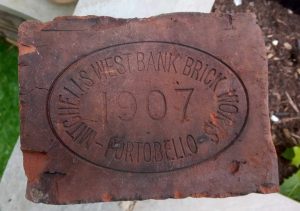West Bank Old brick and Tile Works, Portobello, Edinburgh and Esperston, Midlothian aka Valleyfield Brickworks?
1765 – Cassell’s Old and New Edinburgh – In 1765, Mr William Jamieson, the feuar under Baron Muir, discovered near the Figgate Burn a valuable bed of clay, and on the banks of the stream he erected first a brick and tile works, and afterwards an earthenware manufactory. These public works, as well as others which followed them, necessarily made the place a seat of population.”
1770 – Westbank pottery was erected for Anthony Hillcoat.
1803 – Hillcoat died. The business was taken over by his son and son in law. Roof and drain tile were the initial products.
1821 – The 1985 publication ‘A survey of Scottish brickmarks’ suggests that Alexander Guthrie was operating the works by this time.
Below – 1824 – Westbank Brickwork. (Note – SBH – This map indicates there were two brickworks operating at Westbank at this time but I can find very little on Mr McEwan bar the 1825 entry – perhaps he did not operate for long and the site was taken over by Mr Guthrie although looking at the 1853 map below it appears McEwan may have simply gone out of business and the land otherwise utilised).

1825 – 1826 – D. McEwing, brick and tile manufacturer, West Bank, Portobello. (McEwan?)
1825 – 1826 – Alex Guthrie, brick and tile manufacturer, West Bank, Portobello. Mr Alexander Guthrie, at one time a clerk to the Court of Judiciary. He was also at one time a bookseller in Waterloo Place, Edinburgh, and being in good circumstances he made a considerable addition to Westbank House. After his death, the business was carried on, but with indifferent success, by his son, William Guthrie, who ultimately gave it up, and the works stood idle for some time.
1833 – 1834 – William Guthrie, West Bank Brickworks, High Street, Portobello.
Below – 13/04/1833 – Caledonian Mercury – West Bank Brick and Tile Works belonging to the late Mr Alex Guthrie to let. The works are at least 30 years old at this time.

20/02/1835 – The Glasgow Herald – Brickwork at Rosebank, Portobello (Westbank?).
1837 – The 1985 publication ‘A survey of Scottish brickmarks’ suggests that William Guthrie was operating the works by this time.
1837 – William Guthrie, brick and tile maker, High Street, Portobello.
24/09/1842 – Caledonian Mercury – An article regarding some skullduggery by the Conservatives to obtain a majority of voters in the Edinburgh Leith area by creating fictitious votes … In Portobello a few votes were attempted to be manufactured by Mr Miller of Craigintinny … But only 2 were allowed … Mr Miller’s agent and an advocate … The subjects on which the party claims consist of a tile shed for making tiles, part of West Bank Brick and Tile Works, said shed measuring in length 135 feet by 30 feet in breadth …
Below –
28/01/1843 – Witness (Edinburgh) – West Bank Brick and Tile Works to let.
10/08/1844 – The Scotsman – Notice to proprietors, farmers and others that they can be supplied with drain tiles, handmade, at Miller’s Tilework, Portobello, at 20s per 1000, made from the best clay. A fine opportunity for carts returning empty from the Edinburgh Market.
1847 – A lease of the place was acquired by Mr George Ingram who conducted it with great vigour till his death in 1867. Mr Ingram, who belonged to Selkirk, where he was born in 1810, is described as ”a man of generous sympathies and superior intellectual endowments.” He was a teacher by profession, being a master in the Academy, Davie Street, Edinburgh, which he left in 1837 to be clerk to the Misses Creelman, the then lessees of the Abercorn Brickworks, an office which he held for about ten years until he started for himself at Westbank. During this period, the building trade being brisk, and there being a large demand for bricks, the works were highly remunerative, and Mr Ingram amassed a considerable sum of money. On Ingram’s death, the works were carried on under the management of Mr William Hunter for behoof of his son, Alexander Ingram, and eventually on his own account. But a time of depression in the building trade having ensued, and prices not yielding a remunerative return, he renounced the lease of the place in 1880. After standing some years idle Westbank was re-opened by Mrs Brodie Sherriff from Dunbar in 1884.
21/08/1849 – Edinburgh Gazette – Notice. The Copartnery between the late Miss Ann Stirling Creelman and George Ingram carrying on business at the Westbank Brickworks, Portobello, as brick and tile manufacturers, was dissolved on the 26th day of March last, by the death of the said Miss Ann Stirling Creelman. Catherine Creelman Executrix of Miss Ann S. Creelman.
George Ingram.
22/06/1850 – North British Daily Mail – The latest invention in connection with this subject, and to which our attention has been kindly directed by Mr Telford of the Patent Office, George Street, is an improved socket-joint and bearing for streets and other drains. It may be proper to inform our readers that the stoneware pipes which are now so extensively used, are generally united by the end of one pipe being connected into a socket formed on the next pipe; the consequence is, that when it is required to disconnect the pipes to remove any obstruction from their interior, it becomes necessary to break one or more of them for that purpose. The improved socket-joint which is the subject of this notice is intended to, and does effectually, remove this difficulty, and in a manner far superior to anything of the sort hitherto introduced to public attention. On the end of each pipe are cast flanges which drop into a groove formed in a bottom piece or chair, so constructed as to make an admirable bearing for the joint. In the upper side of each flange is a notch which drops a key most ingeniously constructed in the groove, which is carried round the upper piece or cup of the joint, as well as the lower, thus insuring not only the greater strength but rendering it impossible to turn round the pipes or disconnect them by any amount of force applied latterly. It is hermetically sealed against dirt or wet. The cap can be instantly taken off for examination or to remove an obstruction; both, or even one of the pipes can be lifted out without disturbing the chair or adjoining pipes, and the chair itself not only perfects the joint but from its shape forms capital bearing. In fact, the improved socket joint appears to us to combine all the necessary desiderata for these pipes. We understand it has been registered by Mr George Ingram, West Bank Tileworks, Portobello.
1852 – 1853 – ScotlandsPlaces – Westbank Brick and Tile Works. A large brick and tile works where every description of them are made, the manufacturer Mr Ingram gives employment to about thirty persons
Below – 1853 – Westbank Brick and Tile Works.

1854 – 1855 – Westbank Brick and Tile Works, Portobello.
1855 – 1856 – Geo Ingram, Westbank Brick and Tile Works, Portobello.
1857 – John Milner, West Bank Brickworks, Edinburgh. (Note – SBH – Was Mr Milner perhaps the works manager?).
Below – 06/10/1859 – Southern Reporter – Delays in the transport of drain pipes from Ingram’s Tileworks, Portobello to the Borders. Railway at fault.

31/01/1861 – Glasgow Courier – Deaths – At Mainhill, St Boswells on 23 inst, George Ingram, Esq, of Westbank Brickworks, Portobello.
Below – 13/05/1864 – Kelso Chronicle – George Ingram, Westbank Brickworks, Portobello. Scottish Borders agent is Andrew Thomson, Whitehill, Heiton, Kelso.

1867 – Geo Ingram, brick and tile maker, Portobello.
1870 – 1871 – W Hunter & Co, Westbank Brick and Tile Works, Portobello. p53
26/06/1873 – Southern Reporter – Messrs William Hunter & Co., brick and tile manufacturers, Westbank, Portobello, were charged with illegally employing three young persons under the age of eighteen without having previously entered their names, and without having obtained surgical certificates. They pleaded guilty, and were fined £6.
30/08/1873 – The Scotsman – Fatal accident at Portobello – Yesterday morning about ten o’clock, a young man named Thomas Brown was accidentally killed, at Messrs William Hunter & Co’s brick and tile works, West Bank. Brown was engaged in bringing out clay with a ballast waggon for the brick machine, and when near the tunnel under the turnpike road, he was suddenly caught by a passing waggon, and so severely crushed that he died within an hour and a half of the occurrence. Deceased was unmarried
26/06/1873 – Southern Reporter – Messrs William Hunter & Co, brick and tile manufacturers, Westbank, Portobello were charged with illegally employing three young persons under the age of eighteen without having previously entered their names and without having obtained surgical certificates. They pleaded guilty and were fined £6.
02/12/1879 – Edinburgh Evening News – Yesterday afternoon, a boy named William Matthew, about 9 years of age and residing with his parents at Mossbank, Portobello was drowned in an unused claypit near the Westbank Brickworks belonging to Messrs William Hunter & Co, Portobello … The boys were warned by the manager and the workmen in the brickfield during the day that the ice was in a dangerous state and advised to desist.
19/08/1880 – Edinburgh Evening News – Margaret Catlidge, aged 17, a worker at Messrs Hunter & Co’s Brickworks, Portobello and residing at N0 4 Ramsay Lane had her left hand severely crushed by a brick stamp descending on it while engaged at the works, this forenoon about 11 o’clock. She is under treatment at the Edinburgh Royal Infirmary.
Below – 15/11/1882 – The Scotsman – West Bank Brick and Tile Works, Portobello to let.
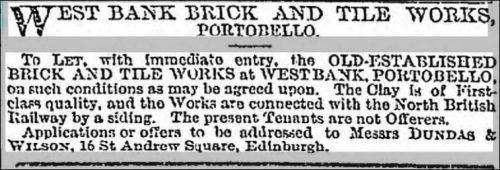
Below – 26/12/1883 – Glasgow Herald – West Bank Brick and Tile Works, Portobello to let.
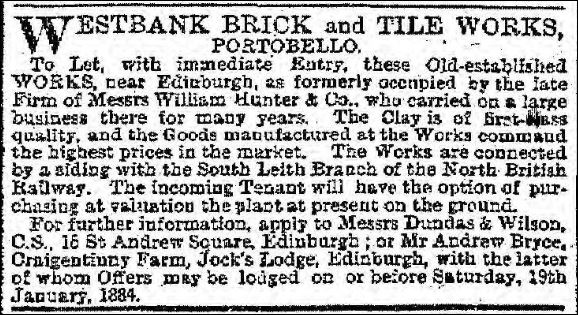
24/05/1884 – Portobello Advertiser – The remaining stock in trade etc at West Bank Brickwork, Portobello will be sold by Public roup on Tuesday, May 27, 1884 consisting of sanitary pipes (various sizes), chimney cans, gas retorts, agricultural drain pipes, circular fire bricks and a lot of miscellaneous goods also 3 close carts, 2 long carts, navvy barrows, dry brick barrows, 4 dry brick bogies, hand barrows, lot of blacksmith and joiners tools, pair of new bellows, and pavement pressing machine (Ralston’s Patent), centrifugal pump, stucco moulds etc.
06/04/1885 – The Scotsman – Brick machine (Ralstons patent) may be seen at Westbank Brickworks, Portobello. M.Brodie Sherriff, Dunbar.
11/07/1885 – Midlothian Journal – We understand that Mr Brodie Sheriff (Mrs Brodie Sherriff) has taken a lease of the old established brick and pottery works of Westbank. As the works are now giving a considerable number of workmen employment and have been fitted up with new machinery &c., the most of the inventions of the late Mr Brodie of Battleblent. The bricks now made are the same as supplied for outside work to the Tay Bridge. All kinds of terracotta vases and flowerpot are made, besides the usual flower pots and chimney cane. Mr Bryce, one of the partners of the late Arm, has been appointed manager.
15/09/1885 – The Scotsman – Portobello Valuation Appeal Court – A valuation Appeal Court for the burgh of Portobello was held yesterday – Provost Christian presiding. Miss M.Brodie Sheriff (Sherriff) appealed against an entry of £160 as the assessable value of West Bank Brickwork. It appeared that the works were let for a period of ten years at a rent of £160, a special rent of £120 being charged this year on account of the tenant’s repairs. These were rendered necessary on account of the Works having been 2 years unoccupied. The assessor said the landlord had simply allowed £40 to be deducted from the rent. The appeal was dismissed.
Below – 1886 – Advert for MB Sherriff.

06/08/1886 – The Berwickshire Advertiser – Annual show at Kelso. Exhibitors … Mr M Brodie Sheriff (Mrs M Brodie Sherriff), brick and tile and pottery maker, Dunbar and Portobello …
Below – 07/03/1888 – Invoice – West Bank Brick, Tile & Pottery Works. M Brodie Sherriff. Water pipes of all sizes, glazed and unglazed. Roofing and drain tiles, chimney cans, garden pots, gas retorts, fire bricks, vent linings, flue covers &c. The return crates must be advised by post. Slogan “Let agriculture flourish”

06/04/1888 – The Scotsman – The Royal Caledonian Horticultural Society … Among them was an interesting exhibit from the Westbank Potteries, Portobello of fancy vases in terracotta, a new local industry which did the makers credit alike for artistic design and excellent workmanship …
02/01/1889 – North British Agriculturalist – Land drainage. Mrs Brodie Sherriff begs to intimate to landowners, factors, farmers and her numerous customers that she has a large stock of drain tiles of all sizes at Battleblent Railway Siding, Dunbar. All orders addressed – Mrs Brodie Sherriff, Battleblent, Dunbar or West Bank Brick and Tile Works, Portobello will be punctually attended to. Mr John Frame, manager, attends Berwick, Duns, Haddington and Edinburgh markets weekly.
1890 – Peter Mitchell took over the firm – bricks, tiles, drain pipes and terracotta were all manufactured and are developing the trade on the old lines, bricks, tiles, and drain pipes forming a prominent feature of their manufacture, while pottery ware for gardens, such as flower pots, vases, and ornamental jars in terra cotta are made in considerable quantity. The bricks, as in Abercom Works, are dried by steam undercover. The exhaust steam from the engine, which used to be blown into the air, being utilised for this purpose and in three days they are ready for the kiln instead of taking a month or so by the old process. The works are lighted by electricity, generated by an engine on the premises. Close upon a hundred men are employed.
28/03/1890 – Portobello Advertiser – Portobello. Chairman’s Committee of Town Council. A meeting was held last night to receive a report from the special committee appointed to carry out the paving of the Promenade. It was reported that through the kindness of Mrs Brodie Sheriff, a yard had been procured for the storing of their material and engaging in the preparatory process. They were empowered to enclose it with a sufficient fence, and proceed with the collection of material, and also to engage a man from Scarborough to superintend the work, as had been kindly offered by the corporation of that fashionable resort.
12/07/1890 – Leith Herald – Before Bailie Brand, in Portobello Police Court on Monday. John Mackay, an elderly man, was charged with the theft, between 1st March and 20th June, from Westbank Brickworks, Portobello of nine metal plates, also with the theft of 45 lb of old iron on July 5 from or near Bailiefield Pottery. He pleaded guilty and stated that hunger caused him to commit the thefts. The Prosecutor having stated that the value of the articles would be about £l, the Bailie passed sentence of thirty days’ imprisonment.
31/05/1892 – Berwickshire News and General Advertiser – Small debt Court, Greenlaw, Berwickshire. M Brodie Sheriff, brick and tile works, Portobello against R Spratt, builder, Ayton for £4 18s 10d. (Note – SBH – As I believe Peter Mitchell took over the Westbank Brick and Tile Works (assuming we are referring to those works with this reference) in 1890, this appears to be a long standing debt that perhaps the trustees of MB Sherriff’s estate were pursuing).
Below – 1894 – West Bank Brick and Tile Works.

Below – 12/01/1894 – The Scotsman – The death of Mr Willam Hunter.

28/02/1896 – Portobello Advertiser – In the Court of Session on Friday last. Lords Moncrieff and Kyllachy heard appeals under the Valuation Lands Act, amongst them being two from Portobello. In the first of these Wakefield Christie Miller, proprietor, and Peter Mitchell & Sons, tenants of Westbank Brickwork, Portobello, appealed against the decision of the magistrates of that burgh which fixed the valuation at £260, and craved that the valuation be fixed £160. The valuation was made of the annual rent of the brickwork, £80 and clay £80 – £160, and £100 interest at the rate of 6 per cent, on £1670, the cost of the erection of a Hoffman kiln which the landlord had erected. The latter item was objected to in respect that it was not a consideration other than the rent, but was interest payable on the sum lent by the landlord. The assessor contended that the erection of the kiln was for behoof of the landlord and the subjects let under the lease having thereby been materially increased in value, the stipulated interest to be paid must be treated as a consideration other than rent, and that he was entitled to include the amount of interest in his estimate of the annual value of the subjects. Mr Dundas, who appeared in support of the appeal, contended that this £100 was not a consideration other than rent, but interest on the cost of the kiln. The improvement was a tenant’s one, and the assessor had no right to put 6 per cent, on the money borrowed. The money could have been borrowed elsewhere. Without calling on Mr Young for the assessor, Lord Killachy said – My Lord, this matter it seems to me to depend upon what was the nature of the transaction between the landlord and the tenants. Mr Dundas has suggested a very ingenious view of that transaction. He says that it was not an agreement by which the landlord was bound to make improvements on these heritable subjects, but that it was an agreement whereby the landlord became an ordinary creditor of his tenants for an ordinary loan of £1000 on the footing of getting interest upon that amount. That is very ingenious but seems to me more ingenious than sound. The substance of this matter was just the ordinary transaction, with which we are all familiar, by which a tenant going to the landlord and desiring to have additional buildings on the land for the mutual benefit of the landlord and the tenant offers the landlord a certain interest on the landlord’s improvement expenditure. That being so, it is familiar law and practice that interest upon such improvement expenditure is always treated as additional rent. I am, therefore, of the opinion that the Magistrates have here taken the right view, and that they have expressed their judgment with great precision. They have stated it thus: -“ The magistrates considered that the case was not to be taken as one where the tenant voluntarily and for his own purposes makes the additions and improvements, but as one where mutual agreement and for mutual benefit the landlord undertakes to make certain improvement expenditure, with a view to enable his tenants to increase their manufacture of his clay, and the tenants agree to pay additional rent in the shape of a percentage on the outlay. I confess I cannot improve upon that language. It states with perfect precision the result of the law of this case. Lord Moncrieff – l agree with your lordship, and I have only to add that the language used in the memorandum with reference to this transaction is in accordance with the view that the interest, which is to be paid on the sum advanced, was of the nature of additional rent. I find that 6 per cent, was to be paid and that at the terms when the rent was payable, with interest and penalty as is stipulated in the lease with reference to non-payment of rent. Then there are provisions that in the event of the lease running out and their possessing by tacit relocation they are to possess these subjects on the same terms. Then the landlord keeps in his own bauds the power to make alterations upon this kiln and takes the tenants bound to consult him in regard to any alterations they may wish to make; and lastly, he takes them bound to leave them in good repair, and to hand the kiln and buildings over to him on their quitting possession of the subjects. I think that the Magistrates have arrived at a sound decision.
1901 – Directory of Clayworkers – J Frame, Rosebank House, Portobello, N.B. (Note – SBH – In 1889 a John Frame was the manager at the Westbank Works).
1901 – Directory of Clayworkers – Peter Mitchell & Sons, West Bank Brick Tile and Pottery Works, Portobello. Edinburgh officer – 34 St Andrews Square. T Add – ‘Mitchell Portobello’ and ‘Lime Edinburgh’.
1903 – Peter Mitchell & Sons, Westbank, Portobello.
12/06/1903 – Musselburgh News – Portobello clay. Is it a mineral … Thomas Hogg, a potter with Messrs Mitchell & Sons, West Bank Brickworks, Portobello said that bricks were made out of clay and a mixture of ashes and lime. Clay found at the bottom of the pit in its pure natural state was pot clay …
Below – 1905 – Westbank Brick and Tile Works are situated at the top of the map and the new works are bottom left. (Abercorn Brickworks are shown middle bottom).

27/06/1905 – The Edinburgh Gazette – Notice of dissolution – The firm of Peter Mitchell and Sons, Lime Burners and Lime Merchants and Brick and Tile Manufacturers, carrying on business at Esperston, Midlothian, and Westbank Brick and Tile Works, Portobello, of which the deceased John Mitchell, residing at Delta House, Inveresk, and Peter Mitchell, residing at Eskbank, were the sole Partners, was dissolved, of mutual consent, as on 14th October 1904, by the retirement therefrom of the Subscribers, the Testamentary Trustees of the said deceased John Mitchell. The whole of the Trustees’ interest in the leases and assets of the dissolved Firm have been transferred to Thomas Bryson Mitchell, Coldstream Mains, Coldstream, who will carry on the Business along with the said Peter Mitchell for their own behoof under the same Firm name of Peter Mitchell and Sons. Edinburgh, 18th May 1905.
T. B. Mitchell, Peter Mitchell, Margaret T Mitchell, James Elder, E. Jackson, T. Waldie.
Andrew Bryce, Westbank Brick and Tile Works, Portobello, Clerk, Witness.
P. Proven, Westbank Brick and Tile Works, Portobello, Clerk, Witness.
John Harkness, 20 Duke Street, Edinburgh, Clerk, Witness.
John D Watson, Solicitor, Haddington, Witness.
Below – 23/09/1905 – The Scotsman – Peter Mitchell & Sons are engaged in active preparations for the transference of their brick, tile and pottery business from West Bank Brick Works to a site on the Craigentinny Farm near Portobello Railway Station where eight acres will in a few months be covered by a new range of buildings and railway sidings. The site now to be deserted has been a brickworks since the middle of the eighteenth century and will it is expected to be feued for the erection of dwelling houses, the northern boundary abutting on Portobello’s extended promenade. The new works will have modern equipment with seven spacious drying sheds, three of them on two storeys. There will be a huge fourteen chambered kiln ( Vaughan’s patent) capable of firing 20,000 bricks per day. Steam or electricity will supply the driving power for the potters wheels instead of hand labour.
Below – 1917 – 1918 – Westbank New Brickworks are shown to bottom left. (This may have been surveyed prior to 1917 and probably prior to the 1913 OS Map as the Abercorn Brickworks are not depicted on the 1913 OS Map).
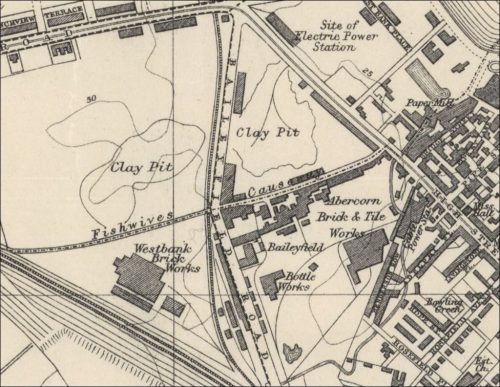
1923 – 1924 – Peter Mitchell & Sons, Lessees of Esperston Lime Works, Gorebridge and West Bank Brick and Tile Works, Portobello. TA Lime.
14/08/1925 – Midlothian Journal – Before Judge McLaren at Portobello Police Court last Monday, John Sherry, alias Burns, of no fixed abode, pleaded guilty to sleeping in an old kiln in Westbank Brickworks, occupied by Peter Mitchell & Sons, without permission or consent of the owner, in the early hours of the same morning. A previous conviction for a similar offence in the same Court on 8th June 1923, was admitted. He was admonished on condition that he would leave the town.
02/11/1925 – The Scotsman – The late Mr Peter Mitchell, Eskbank. The death took place on Saturday afternoon, after some weeks’ indisposition, of Mr Peter Mitchell, Beechwood, Dalkeith, at the age of 63. A native of East Lothian, Mr Mitchell was a partner of Messrs Peter Mitchell & Sons, Valleyfield Brickworks, Portobello and of Esperston Limeworks Gorebridge. For the last 20 years, he had been an elder in the Dalkeith West Parish Church and he previously held a similar office in Inveresk Parish Church when resident at Musselburgh. Mr Mitchell, who was well known over the country, leaves a wife and two sons. (Note -SBH – I assume the reference to Valleyfield Brickworks is the same as Westbank Brickworks. This is the only reference to Valleyfield I can find – does anyone know the connection between the two place names or is it an error in this newspaper article?).
05/02/1932 – Musselburgh News – Mr George Hogg, Portobello, retired on Sunday from active participation after 53 years in connection with brass bands in Scotland, when he handed over the baton to his successor, Mr W. F. Hannaford, at the rooms of the City Band in Hanover Street, Edinburgh … Mr Hogg, who is 68 years of age, still follows his trade at the Westbank Brickworks, where he has been employed for a very lengthy period.
19/05/1933 – Musselburgh News – Last Sunday the death took place of Mr James Holligan, after a serious illness, at his residence at 50 High Street, Portobello, at the age of 71 years. Mr Holligan, who was a native of Portobello, was the eldest son of the late Mr Daniel Holligan, of Rosebank. He leaves a grown-up family, his wife having predeceased him many years ago. Mr Holligan, who went to work at the age of 13 years, began his career as a day potter in the Westbank Brickworks of Messrs Hunter when 15 years old, and served with the late Mrs Brodie Sheriff. and then with Messrs Peter Mitchell & Sons. He had been 56 years in the works as a thrower, and in January 1932 he was presented with a handsome silver medal by the Institute of Clayworkers on the occasion of having completed 55 years service in the trade and also received a cheque from Messrs Mitchell. He was one of the stalwarts of St John’s Church having been associated with it all his life. A lifelong abstainer, he was for over forty years connected with St John’s Temperance. He has had a very long connection with the Royal Oak Yearly Friendly Society, of which he has been treasurer for more than forty years. Although of rather a retiring disposition, Mr Holligan took a very deep interest in matters concerning his native town. He was very proud of the fact that he was born on the anniversary of the birth of the National Bard. The funeral took place on Wednesday from St John’s io Portobello Cemetery at Joppa.
1936 – The works closed as the clay pit was now exhausted.
23/12/1936 – The Scotsman – Brickworks to close – Portobello firm’s decision. Clayfield exhausted. The clay brick industry in Portobello, Edinburgh will come to an end shortly, the well-known firm of Peter Mitchell & Sons (Ltd) at West Bank, Baileyfield having announced their intention of closing down before next year. The cessation of work will mean the throwing out of employment, of over 70 workers but they will not all leave at the same time. Some of them will be retained to dismantle the works. Exhaustion of the clay available is the cause of the works closing at a time when there is a shortage of bricks of the type made by the firm. There is still a quantity of clay in Portobello but it cannot be worked owing to the fact that either the railway runs over it or it is built over. The field which is being closed down has lasted about 35 years. Before 1906 the firm worked a clay bed where the Edinburgh Corporation Electric Power Station now stands. They took over the works from the late Mrs Brodie Sherriff in 1890. When they removed to Fishwives Causeway at the back of the Baileyfield Locomotive Works, they erected a new up to date plant. Since 1750 bricks have been made in the neighbourhood of Portobello and will still be made in the district. They will not, however, be of the clay variety but will be of a composite character. It is expected that the firm responsible for them and other Edinburgh firms will be more or less able to cope with the demand though a representative of Messrs Mitchell & Sons acknowledged yesterday that there was a shortage of bricks and that bricks were being imported into Edinburgh from the West of Scotland despite the additional cost of haulage. Messrs Mitchell & Son made tiles and pottery as well as bricks and their decision to go out of existence will be a decided blow to industrial Portobello.
Below – 27/02/1937 – The Scotsman – Westbank Brick and Tile and Pottery Works Portobello. Sale – Messrs P Mitchell & Sons Ltd, Portobello.
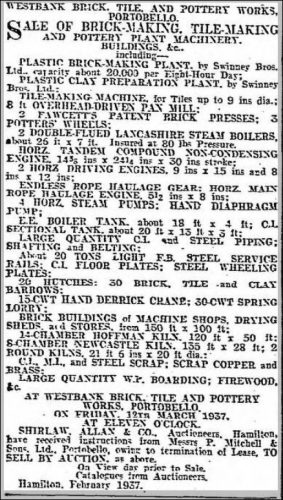
Below – 1938 – Westbank Brick and Tile Works.



















